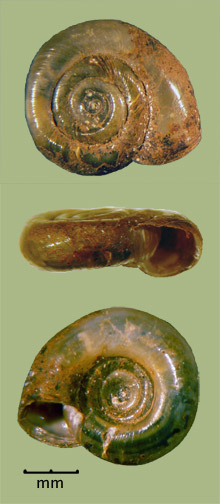> Habitat & Distribution
Sparse and widely-scattered populations of P. armigera extend south as far as Florida, but are much more common further north, especially above the glacial maximum, west to Nebraska (Clarke, 1981; Thompson, 1999; Baker, 1928). Northern populations reach maximum abundance in smaller ponds and intermittent lentic habitats including marshes and wetlands, especially associated with submersed macrophytes and decomposing vegetation (Pip, 1985; Jokinen, 1992; Jokinen, 2005). In Canada, Clarke (1979) considered populations of P. armigera to be characteristic of older eutrophic ponds or swamplike ecosystems. In southern Atlantic drainages, P. armigera seems restricted to swamps, ponds, and sluggish creeks of the coastal plain. We have but a single record in the (relatively well-drained) Tennessee/Cumberland and but two records in The Great Plains. FWGNA incidence rank I-4.
> Ecology & Life History
Planorbula armigera populations seem adaptable to a variety of water chemistries and have the physiological capability of aestivation if habitats dry (McKillop 1985, Jokinen 1992, Jokinen 2005). Jokinen s (1987) analysis of the distribution of P. armigera in Connecticut and New York led her to classify it as a C-D tramp, potentially present in nearly every community. Dillon s (2000: 360-363) reanalysis of these data suggested that P. armigera populations in Connecticut may be R-adapted, common in rich but unpredictable environments, demonstrating high reproductive effort relative to body size. Populations typically display at least two breeding cycles annually, individuals not living for more than one year (McKillop 1985, Brown 2001). This is life history C or H(s) of Dillon (2000:156 162).
> Taxonomy & Systematics
The classification of the Planorbidae proposed by the tag team of Baker (1945) and Hubendick (1955) remains, after 50 years, the basis for our understanding of this large and diverse family of pulmonates worldwide. See my essay of 11Apr08 below. Synonyms of Planorbula armigera include Planorbella armigera, Planorbis armigera, Planorbis armigerus, Planorbula jenksii, Segmentina armigera, and Segmentina wheatleyi (Stewart and Dillon 2004, Stewart 2006).
> Maps and Supplementary Resources
- Planorbula distribution in the drainage of The Ohio
- Planorbula distribution in Atlantic drainages (2023)
- Planorbula record in the Tennessee/Cumberland (2022)
- Planorbula distribution in The Great Plains (2024)
- Virginia species account with county distribution (2011)
> Essays
- North Carolina populations of Planorbula were mentioned in my post to the FWGNA blog of 17Nov05, Aerial Dispersal of Freshwater Gastropods.
- See my post to the FWGNA blog of 11Apr08 for a review of the Classification of the Planorbidae.
- Or view the (Hubendick 1955) classification of North American planorbids in a tabular format [here].
> References
Baker, F. (1928) Freshwater
Mollusca of Wisconsin, Part I, Gastropoda. Bull. Wisc. Geol. Natur.
Hist. Survey, no. 70. University of Wisconsin Press, Madison.
Baker, F. C.
(1945) The Molluscan Family Planorbidae. Urbana:
University of Illinois Press.
Baker, H. B. (1946) Index to F. C. Baker's "The Molluscan
Family Planorbidae." Nautilus, 59: 127-41.
Brown, K. M. (2001)
Mollusca: Gastropoda. In: J. H. Thorp and A. P. Covich, eds., Ecology
and Classification of North American Freshwater Invertebrates, Academic
Press, New York. Pp. 297-329.
Burch, J. B. (1989)
North American Freshwater Snails. Malacological Publications, Hamburg,
Michigan.
Clarke, A. H. (1979)
Gastropods as indicators of trophic lake stages. Nautilus
93:138-142.
Clarke, A. H. (1981)
The Freshwater Molluscs of Canada. National Museum of Natural Sciences,
National Museums of Canada, Ottawa, Canada.
Dillon, R. T., Jr. (2000)
The Ecology of Freshwater Molluscs. Cambridge University Press,
Cambridge, United Kingdom.
Hubendick, B. (1955)
Phylogeny in the Planorbidae. Trans. Zool. Soc. London 28:
453-542.
Jokinen, E. H. 1987.
Structure of freshwater snail communities: species-area relationships
and incidence categories. Amer Malac Bull 5:9-19.
Jokinen, E. H. 1992.
The Freshwater Snails (Mollusca: Gastropoda) of New York State. NY
State Mus Bull 482, Albany, New York.
Jokinen, E. H. 2005.
Pond molluscs of Indiana Dunes National Lakeshore: then and now. Amer
Malac Bull 20:1-9.
McKillop, W. B. 1985.
Distribution of aquatic gastropods across the Ordovician dolomite
Precambrian granite contact in southeastern Manitoba, Canada. Can J
Zool 63:278-288.
Pip, E. 1985.
The ecology of freshwater gastropods on the southwestern edge of the
Precambrian Shield. Can Field-Nat 99: 76-85.
Stewart, T. W., and R. T.
Dillon, Jr. 2004. Species composition and geographic
distribution of Virginia s freshwater gastropod fauna: a review using
historical records. Amer Malac Bull 19:79-91.
Stewart, T. W. 2006.
The freshwater gastropods of Iowa (1821-1998): species composition,
geographic distributions, and conservation concerns. Amer. Malac. Bull.
21: 59 75. 21: 59 - 75.
Thompson, F. G.
(1999) An identification manual for the freshwater snails
of Florida. Walkerana 10: 1 - 96.








